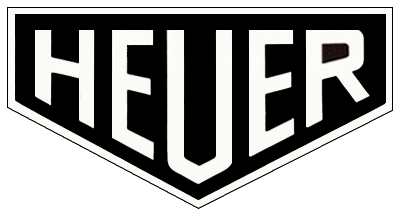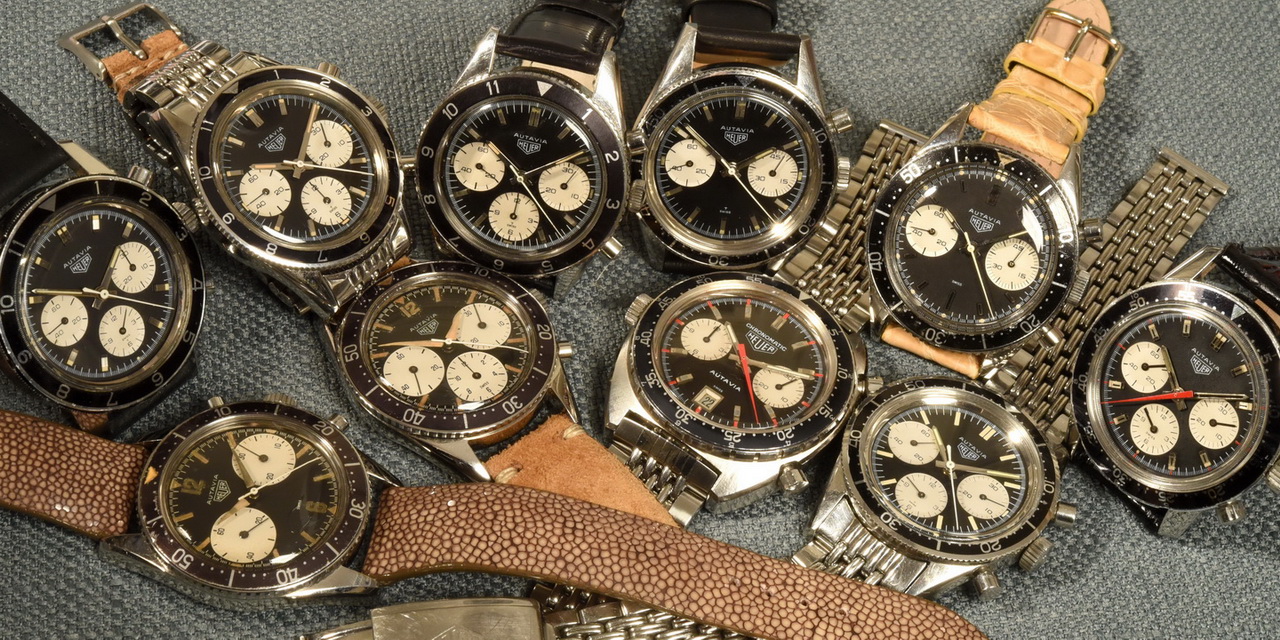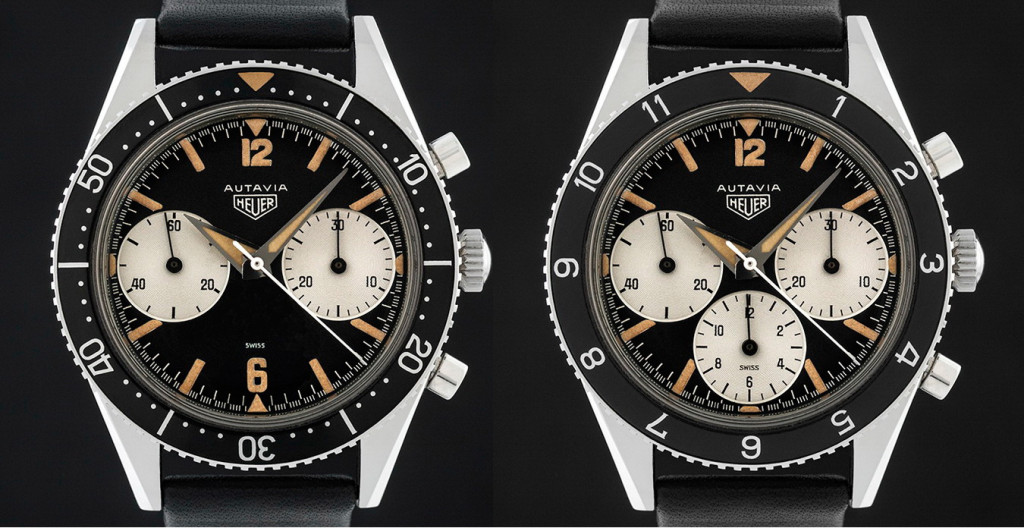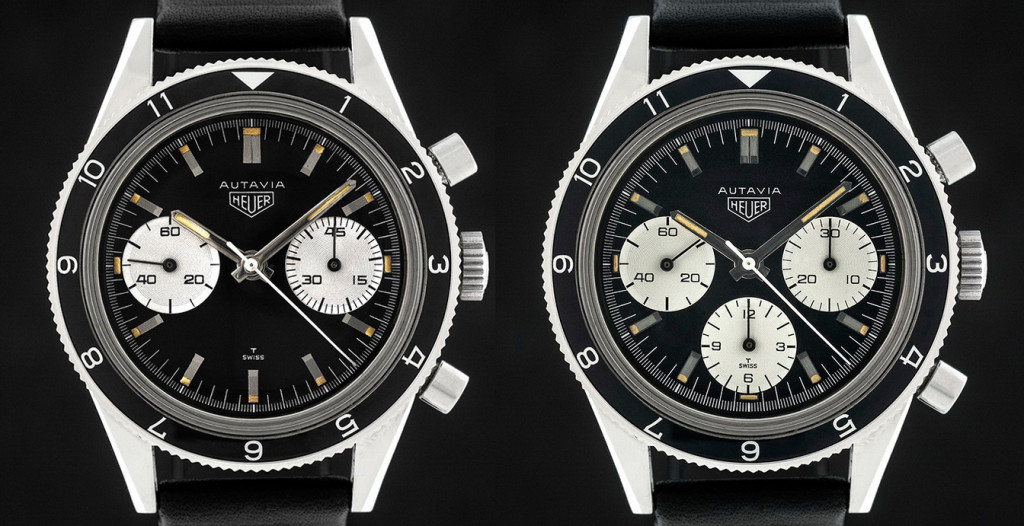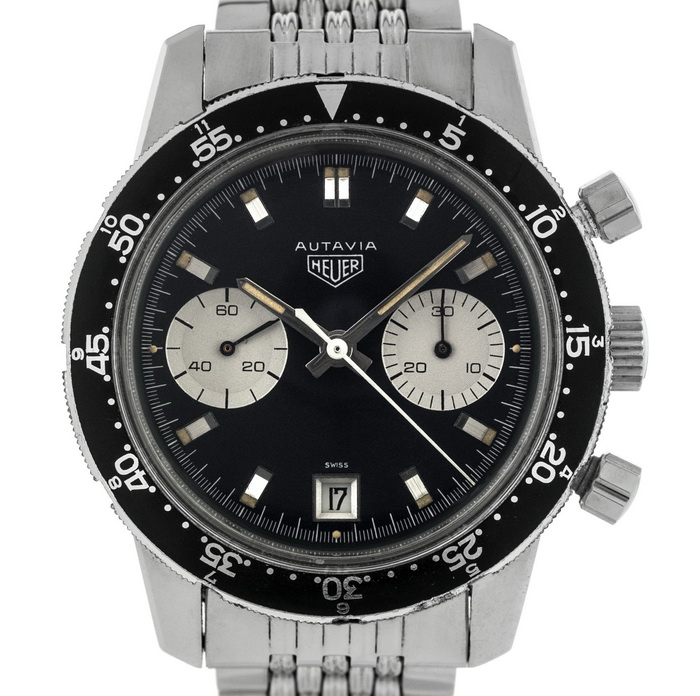By Rich Crosthwaite and Jeff Stein
Images by Paul Gavin/heuerworld.com
On March 10, 2016, TAG Heuer announced that it would re-issue the Autavia in 2017, with enthusiasts selecting the model to be re-issued from among 16 choices dated 1962 through 1969. There is great interest in these “Early Autavias”, and at the request of TAG Heuer we present this detailed look at these models.
Fifty four years after Heuer introduced the Autavia chronograph, we can put this watch into its proper perspective. The Autavia was Heuer’s first chronograph to have a model name, as the previous chronographs were identified only by their reference numbers. The Autavia was Heuer’s first chronograph to incorporate a rotating bezel, a useful tool for measuring elapsed time, for determining speed over a measured distance, or for tracking time in a second time zone. Perhaps we explain these first two attributes by the third unique aspect of the Autavia – it was the first wristwatch that Jack Heuer, the great grandson of company founder Edouard Heuer, personally created for the company, at age 30.

These 10 Autavias cover the range from the very first models, introduced in 1962, to the first automatic Autavia, introduced in 1969
Considering these three “firsts”, we can understand why the Autavia was the chronograph favored by racers and their teams in the 1960s. The name “Autavia” was perfect for motorsports, declaring that this chronograph was built for racers and pilots. The rotating bezel enhanced the usefulness of their new chronograph, offering the navigator, crew member or team manager a new tool. Most of all, as Jack Heuer traveled from track to track and from race to race, selling stopwatches, timing equipment and other gear, he now had the perfect chronograph for racers, whether club racers, rally drivers or world champions. Mario Andretti and Jochen Rindt wore Autavias in the 1960s. Derek Bell, Steve McQueen, Clay Regazzoni, Jo Siffert and Gilles Villeneuve followed suit in the 1970s. No other watch had this dominant presence, in the pits and paddocks, during the golden age of racing and rallying.
In this posting, we will take an in-depth look at the first of the Autavia chronographs, the manual-wind models introduced by Heuer over the period from 1962 through 1969. Rather than providing a complete description of each of the approximately 25 models and executions, we track the development of these chronographs by focusing on the changes from one model or execution to the next. It is difficult to draw precise lines between the different models and executions. Rather than having clear breaks between different models — as we have with model years for most cars — Heuer typically changed cases, dials, hands, bezels and other elements at different points in time. As existing supplies were used up, Heuer began incorporating the new components, sometimes resulting in “transitional” models that puzzle collectors, even to this day. In this posting, we generally focus on the changes in the Autavia dials, addressing other elements as they were paired with particular dials.
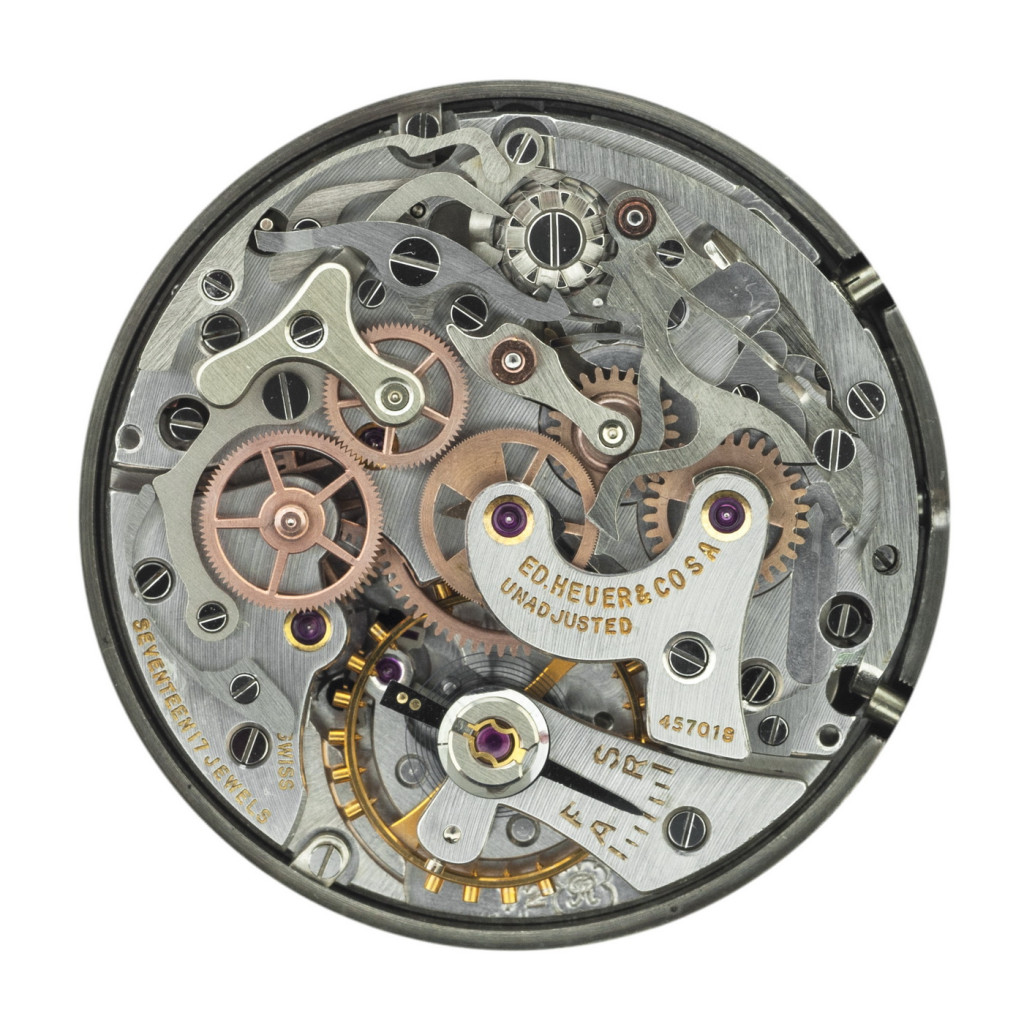
Valjoux 72 movements in the earliest Autavias are marked “Ed. Heuer & Co.” and also have a serial number
While there were numerous variations of the 1960s Autavias, involving different cases, dials, hands, bezels, pushers, crowns, movements and markings, all these early Autavias shared some essential features. The 1960s Autavias were manual-wind chronographs, in round stainless steel cases, with rotating bezels, that were “Guaranteed Waterproof.” They were rugged to withstand races or flights; they were legible for the driver, navigator or pilot; and they were built well enough that collectors continue to enjoy them, 54 years after they left the factory.
THE SCREW-BACK CASE AUTAVIAS
1st Execution Dial – Reference 2446 (Three Registers) and Reference 3646 (Two Registers)
Introduced by Ed. Heuer & Co. in 1962, the “Autavia” was the first Heuer chronograph to have a model name. (Previous models were known only by their reference numbers, for example, reference 347 or reference 2447). The new Autavia was offered as a three-register model (Reference 2446) and a two-register model (Reference 3646), both with a black dial and white registers.
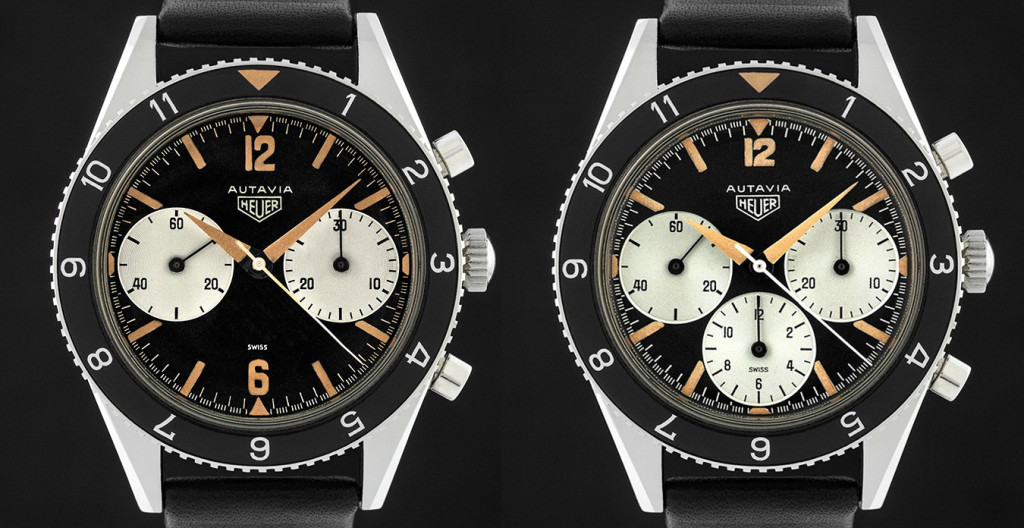
The very first Autavias had oversized registers (“Big Subs”) and the hands were covered with tritium (“All Lume”)
The first execution Autavia dials had oversized registers (which today’s collectors call “Big Subs”), which distinguish this first execution dial from all executions of the Autavia that would follow. The dials had radium applied “lume” markers and were signed “Swiss” or “Fab Suisse” in the lowest sub register (for the three-register model) or “Swiss” on the lower part of the dial, above the numeral “6” (for the two-register model).
The hands of the first Autavias were dauphine shaped, with the first execution hands being “all lume” applied and later hands being wide steel dauphine hands, filled with radium luminous material (with ever thinner lume hands during its lifecycle).
The three-register model was powered by the Valjoux 72 movement, and was marked with a movement serial number on the bridge; the two-register model was powered by the Valjoux 92 movement, but carried no serial number. The early two-register models had 30 minute chronograph capacity, which was soon extended to 45 minutes. All movements in these first Autavias were signed “Ed Heuer”.
Cases were 39 millimeters (width of the bezel diameter), with the beveled lugs having three surfaces — top, side and chamfer between these two main surfaces. The case backs have the name “Autavia” above the Heuer shield, and are marked “Stainless Steel Chronograph – Waterproof – Guaranteed 330 Feet Under Water”, an inscription that would continue for all the 1960s Autavias.
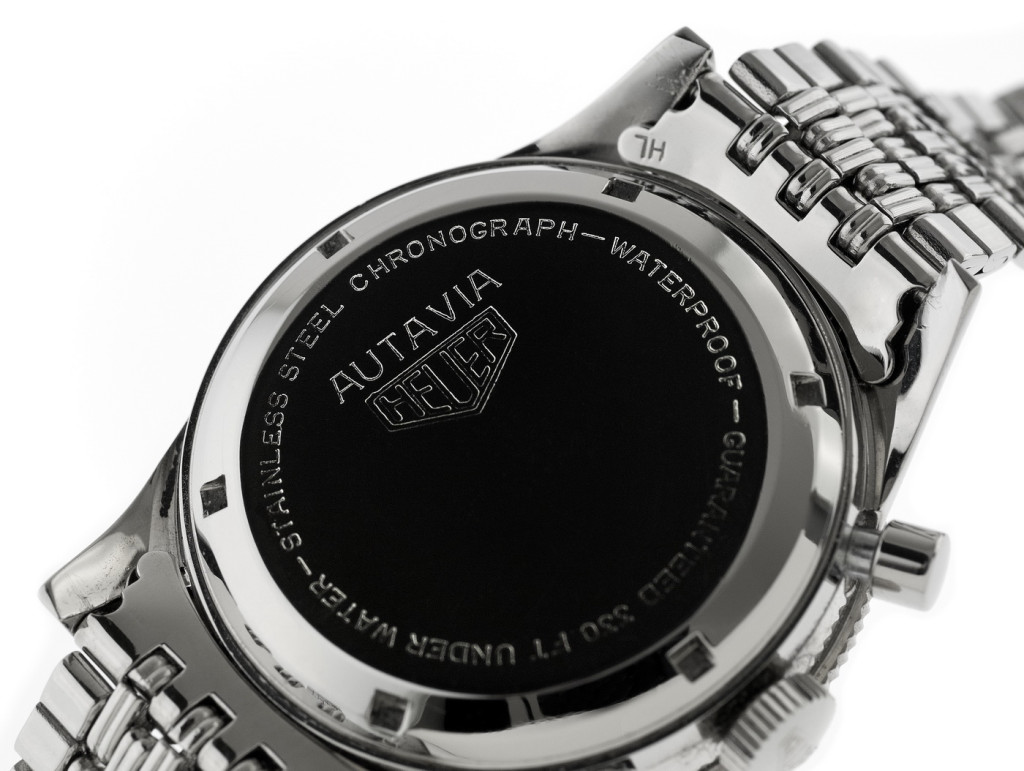
All early Autavias have the same marking on the case-back — “Stainless Steel Chronograph — Waterproof — Guaranteed 330 Ft Under Water”
The case-backs have two steps, to accommodate the thicker three-register movements (Reference 2446), or one-step, for the thinner two-register models (Reference 3646). Case-backs are signed “Ed Heuer” inside. Bezels have a wide triangular Radium lume piece at the top and are marked for minutes, hours, or decimal minutes. Note the early examples had smaller 4.0 millimeter pushers and a unique unsigned domed crown.
The serial number range for this first execution “Big Subs” Autavia is 488xx to 530xx.
2nd Execution Dial – Reference 2446 (Three Registers) and Reference 3646 (Two Registers)
Around 1963 or 1964, Heuer updated the Autavia by significantly revising the dial. The “Big Subs” of the first execution yielded to smaller sub registers, which are a more standard size for the era and continued for the life of the 1960s Autavia. Hours were marked by a combination of luminous dots and applied metal markers, with no use of numerals.
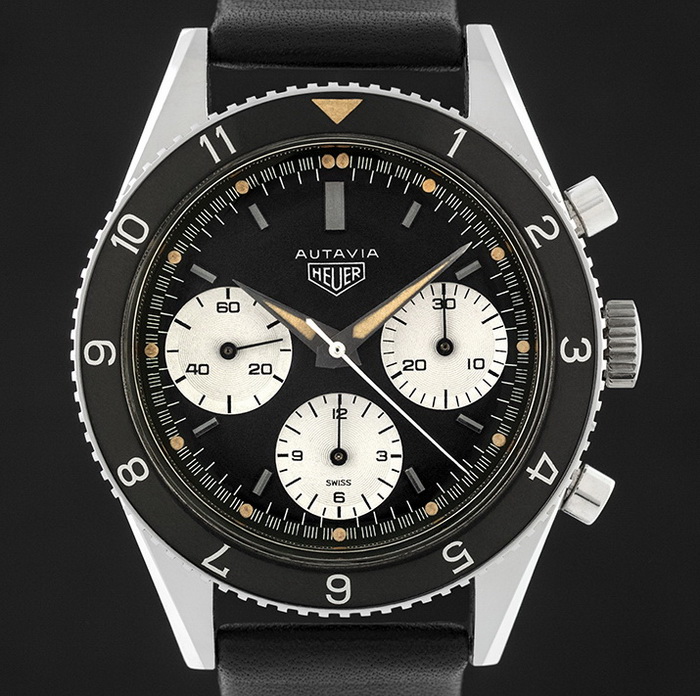
The second execution Autavia dial has unique markers, combining luminous dots and applied metal markers.
The dials had applied “lume” plots of Radium or Tritium (dependant whether before or after the legislation mandating this change), were initially signed “Swiss” at bottom and later “Swiss T” in lower sub register (for the three-register model) or “Swiss” then “Swiss T” (for the two-register model), with the “T” indicating the use of Tritium. Hands were steel dauphine hands, first with wide lume and then with thinner lume with Radium or Tritium applied. The Valjoux 72 and Vajoux 92 movements were initially signed “Ed Heuer” and later “Heuer Leonidas”, after the 1964 merger of the two companies.
Cases housing the second execution dials were unchanged from those used with the first execution dials, except that they were initially signed “Ed Heuer” inside and were later marked “Heuer Leonidas”. Bezels have a wide lume triangular piece at the top, and are marked for minutes, hours, or decimal minutes. Crowns continue to be unsigned, and the size of the pushers increased to 4.4 millimeters for this execution, with this size continuing for later models of the Autavia.
The serial number range of this execution is 53xxx to 59xxx.
3rd Execution Dial – Reference 2446 Transitional Case
Around 1965, Heuer introduced what today’s collectors call the third execution Autavia dial. This third execution dial had large steel hour markers, with lume plots applied directly on the ends of the markers, with the bottom sub register marked “Swiss T”.
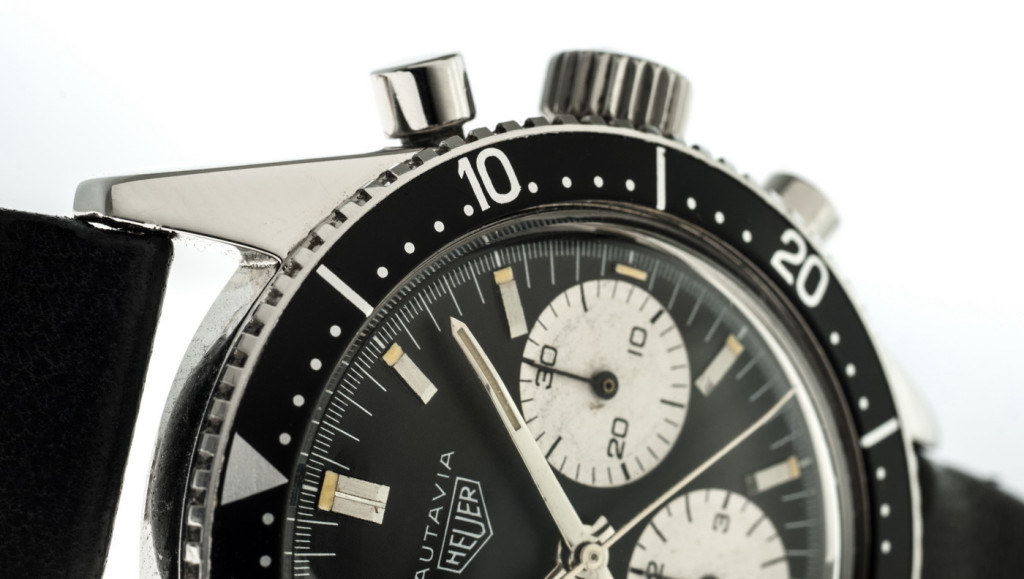
This “Transitional” case houses the third execution dial, with its applied metal markers, with polished “matchstick” hands.
The initial batch of these dials are used in a case which collectors call “Transitional” — this case has straight non beveled lugs (with no chamfer between the top and side surfaces), marking the transition between the earlier execution beveled-edge cases (with a wider bezel) and the later execution beveled-edge cases (with a thinner bezel). Hands were the thin matchstick variety with matching Tritium. The two step case backs were also signed “Heuer Leonidas” inside. Bezels were the “wide” no lume version, marked for minutes or hours, which were also sometimes used on earlier executions at service. We see 4.4 millimeter pushers and unsigned crowns on this execution. The narrow serial number range for this execution with this Transitional case is approximately 828xx to 83xxx.
3rd Execution Dial – Reference 2446 (Three Register) and Reference 3646 (Two Register)
Introduced in 1965/66, the longest running of all the screw back case models was the third execution dial in the second version of the beveled-edge case. This second execution screw-back case had the same size and basic geometry as the first execution case, with the most noticeable difference being a thinner bezel on the new case.
Today’s collectors have named the three-register model the “Rindt”, as it was the model worn by Jochen Rindt, the 1970 Formula One World Champion, while the two-register model is called the “Andretti”, as this model was worn by Indianapolis 500 winner and future Formula One World Champion, Mario Andretti.
Other key elements are carried forward from the previous Transitional model, with the dials signed “Swiss T”. The bezels are marked in hours 1 through 12, hours 13 through 24 hours, minutes and also with a tachymeter scale. This was the first Heuer chronograph to offer a tachymeter bezel, a feature that would become popular in the 1970s with the “Siffert” and “Viceroy” automatic Autavia models.
We see a mix of unsigned and Heuer signed crowns (earlier in serial range tend to be unsigned). The two-register models have two different bezels, initially a “Transitional” wide bezel then later the thinner bezel version as on the three-register model. The serial range is 85xxx to 97xxx (three register) and 826xx to 83xxx for the wider bezel two-register case and 84xxx to 97xxx for the thinner bezel two-register case.
Special Order Tachymeter Dial – Reference 2446 (Three Register) and Reference 3646 (Two Register)
This version of the Autavia is almost identical to the standard 3rd execution Autavia in its key elements, except that the special “Tachymeter” dial replaces the standard dial. This dial execution is thought to have been available only as a “special order”.
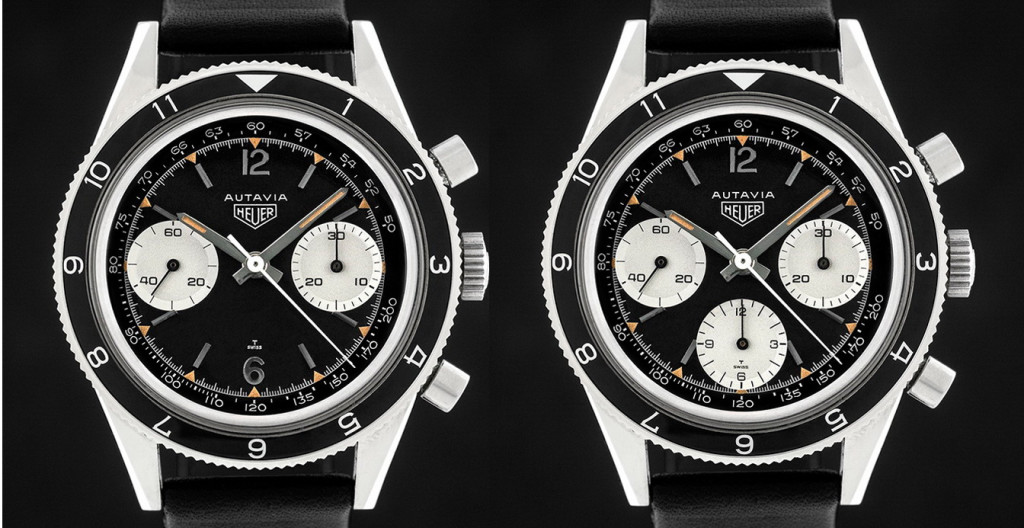
This special order dial has an outer tachymeter scale on the dial edge, plain steel markers, and “triangle” lume plots applied directly to the dial.
This black dial continues with either two or three white sub registers, but has an outer tachymeter scale on the dial edge (marked from 50 to 200), a different style of plain steel markers, and “triangle” lume plots applied directly to the dial. The hour and minute hands are also slightly shorter than on the standard 3rd execution Autavia, due to the minute track being further towards the dial centre. The bezels are marked in hours 1 through 12 or hours 13 through 24. The case, movement and other details are the same as the standard 3rd execution above, with serial numbers in the range from 85xxx to 97xxx.
4th Execution Dial – Reference 2446 (Three Register)
The last dial used in the screw-back case Autavia (known as the fourth execution dial) is thought to have been introduced for a very short production run circa 1968, just prior to the start of the compressor case Autavias. The distinctive feature of the dial is its lume hour Tritium markers applied directly to the dial, reminiscent of the very first Autavias except that no numerals are used.
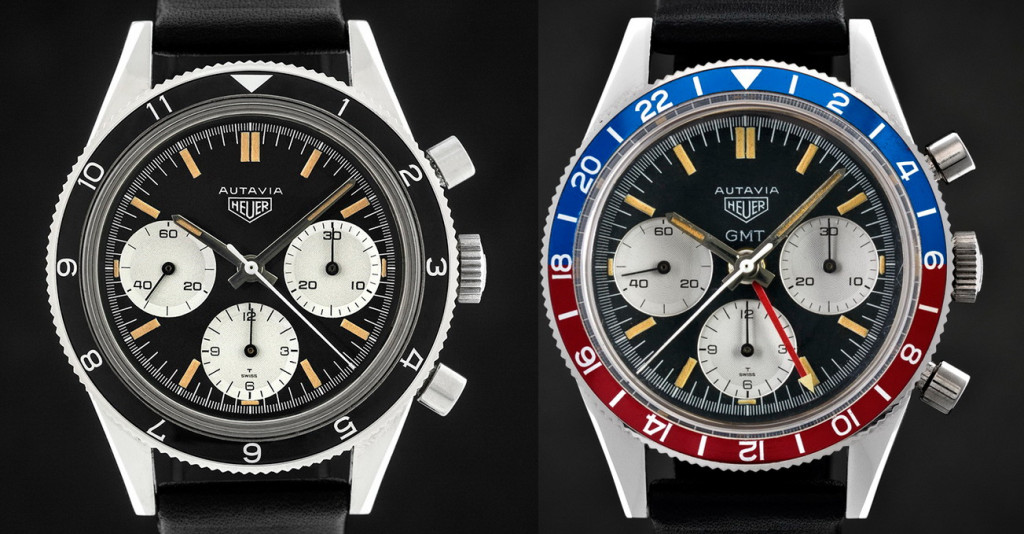
The “All Lume” dial was used for the last of the standard screw-back Autavias and the first of the Autavia GMTs.
Hands were the plain, thin steel matchstick variety and also were Tritium filled. The bezels were the same thin style seen on the later third execution, available in same four versions — hours 1 through 12, hours 13 through 24, minutes, and tachymeter. The serial range is circa mid 9xxxx-100xxx. Crowns are signed “Heuer”, with this continuing on later models.
First Autavia GMT (4th Execution Dial) – Reference 2446 GMT
Around 1968, Heuer introduced its first GMT chronograph, which used a variation of the fourth execution Autavia dial in a screw-back case. In addition to the standard hour and minute hands, a GMT hand makes one revolution in 24 hours. This GMT hand may not be set independently of the primary hands, but the bezel is rotated to the appropriate plus / minus position and the time in a second time zone is determined by reading the GMT hand on the bezel. The movement is a modified version of the Valjoux 72, known as the Valjoux 724. The dial is the same as the fourth execution dial version (above) except for the inclusion of the “GMT” lettering below the Heuer shield. The hands are plain steel matchstick with the inclusion of a red “GMT” hand, with arrow head. The thin style bezel came only as a blue and red version, marked with the even numbers 2 through 22. This first execution Autavia GMT had a very short production run, with the serial number range circa 100xxx.
THE COMPRESSOR CASE AUTAVIAS
First Execution — Reference 2446C (Three Register) and 7763C (Two-Register)
In 1968, Heuer changed the case used for the Autavia from the previous screw-back configuration to a snap-back design compressor case. The first execution compressor case had a larger diameter (40.5 mm bezel diameter) and deeper case than the previous screw-back models, with wider lugs. Despite the new construction, the case-back markings remain the same as on all previous models — “Stainless Steel Chronograph – Waterproof – Guaranteed 330 Feet Under Water”.
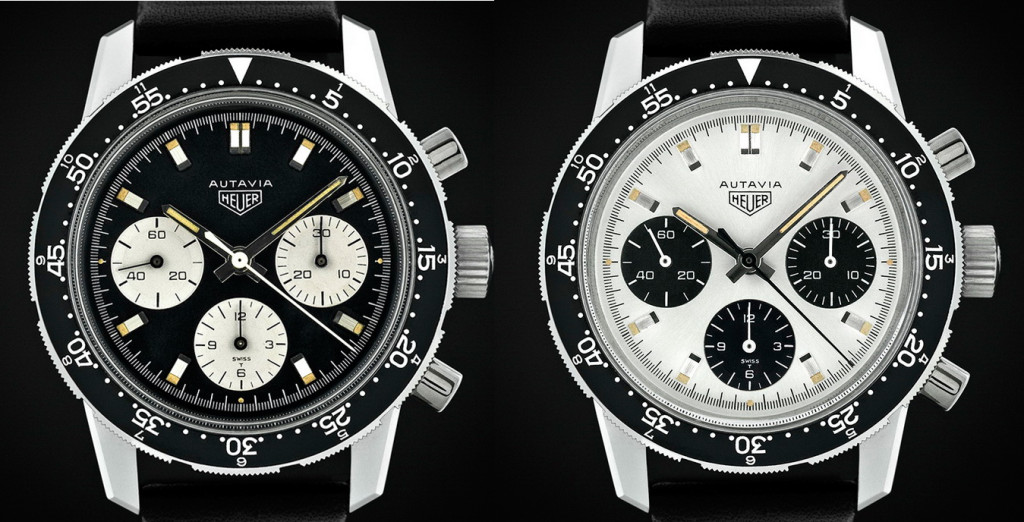
Heuer redesigned the Autavia case to use a “Compressor” (snap-back) design, then produced a “Panda” dial to be used in this new case.
The black dial has three white standard size sub registers (Reference 2446C) or two white standard size sub registers (Reference 7763C), with plain silver hour markers with Tritium lume plots applied. The Tritium filled hands are the familiar plain steel matchstick variety, carried forward from the later screw-back case executions. The bezel is wider and less deep than on the earlier Autavias, with groups of serrated teeth, and is available in hours, minutes/hours and tachymeter versions. We see plain pushers on earlier Autavias and fluted pushers on later watches, with all crowns signed “Heuer”. While the Reference 2446C continues to be powered by the Valjoux 72 movement, the two-register Reference 7763C model uses the Valjoux 7730 movement. The serial range is circa 108xxx -145xxx in several groups.
Silver-Dialed Autavias – Reference 2446C SN and Reference 7763C SN
This first execution compressor model is the only Autavia to feature a true “panda” dial design, a silver dial with either two or three black sub registers. These dials are thought to have been an early test (circa 1968) for the American market, however it appears that these models never went into production. These “Swiss” signed silver dials have black sub registers, with plain silver hour markers with Tritium lume plots applied. The Tritium filled hands are the now-familiar plain steel matchstick variety. These silver-dialed versions of the 2446C and 7763C Autavias are housed in the same cases as the standard models, and use the same movements – Valjoux 72 (Reference 2446) and Valjoux 7730 (Reference 7763).
First Execution – Reference 7863C
In the mid-1960s, Heuer incorporated a date window into the Carrera chronographs, and in 1968/69, Heuer brought this feature to the Autavia, with the Reference 7863C Autavia (known as the “Autavia 30 Dato”).
The black dial has two white sub registers and is marked “Swiss” above the date window. The Valjoux 7732 movement is signed “Heuer Leonidas”. Other elements (hands, bezels, crown and pushers) are carried forward from the Reference 2446C and 7763C Autavias. Serial range is circa 138xxx / 139xxx.
1st Execution – Reference 2446C GMT
As Heuer transitioned the Autavias from screw-back cases to compressor cases, it was sensible that the Autavia GMT chronographs should undergo the same transition. Accordingly, in around 1969, Heuer moved the Autavia GMT chronograph to the Reference 2446C compressor case.
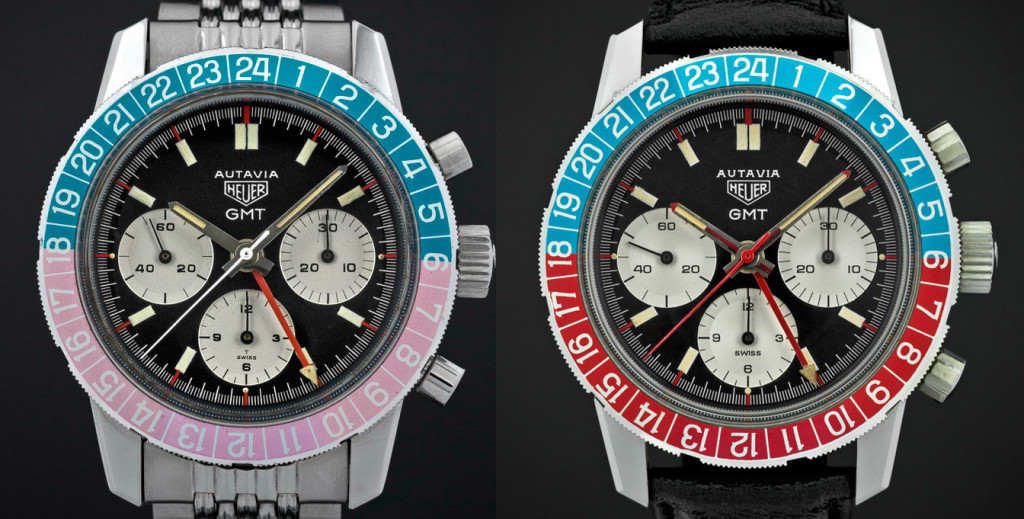
As the Autavia moved from a screw-back case to a snap=back case, the Autavia GMT made the same transition.
The first execution 2446C GMT featured a black dial with three white sub registers, and was signed “Swiss T” in the bottom (hours) register. The dial had Tritium lume applied hour markers, for better legibility over the standard silver markers, as the watch was designed to be used by airline pilots. The Autavia GMT uses the same style plain steel matchstick Tritium filled hands as the standard Autavia, with a red GMT hand and a white chronograph second hand. The bezel is the same as that used on the standard compressor case, except that it is red and blue with 24 numerals, with the night hours (19 to 5) on the blue area and the day hours (6 to 18) on the red area. We see plain pushers on the earlier models and fluted pushers on the later production models, all with Heuer signed crowns. The movement is the Valjoux 724, brought forward from the screw-back Autavia GMT. The serial range is 111xxx to 140xxx in several groupings, as well as some in 190xxx.
Second Execution — Reference 2446C (Three Register) and 7763C (Two-Register)
The second execution Reference 2446C and Reference 7763C Autavias were introduced circa 1970 and were largely similar to the first execution of these models. The steel markers on the dials now have black stripes, with adjacent red accents, and the hands were matching Tritium filled steel hands, also with black stripes.
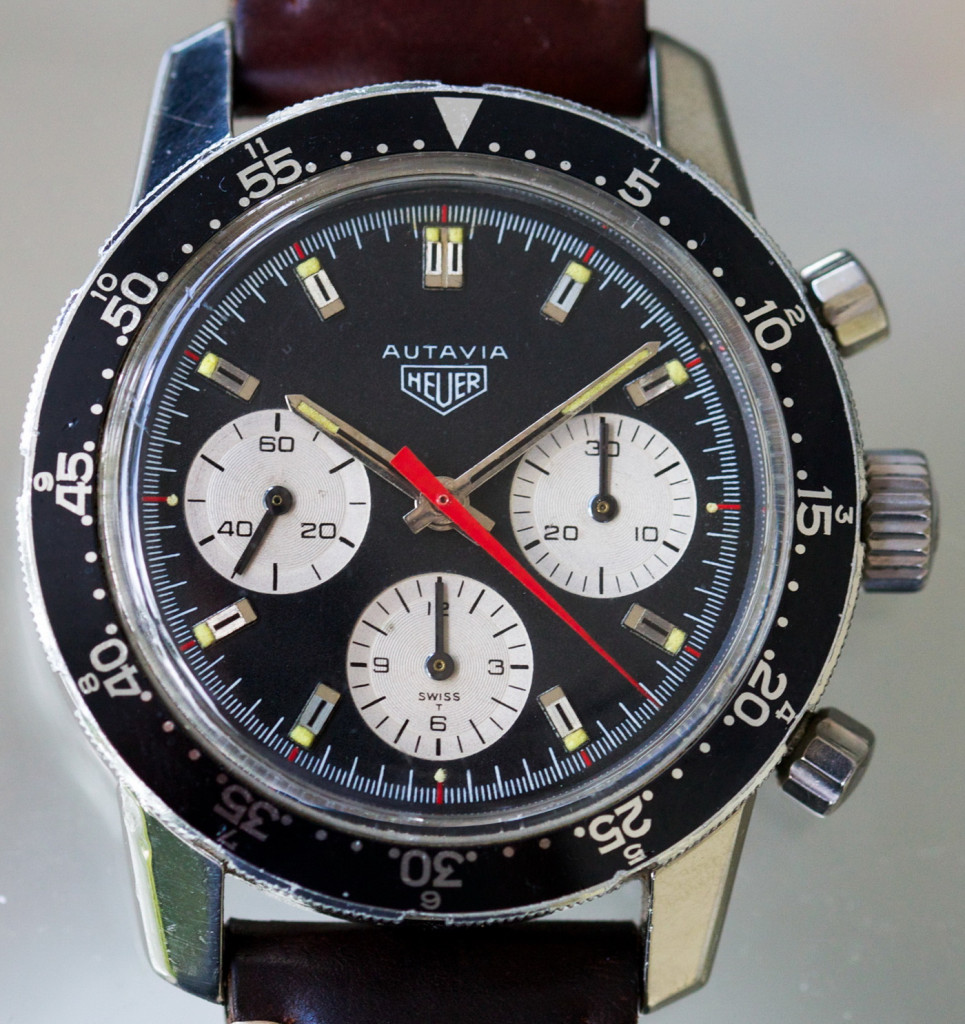
The second execution Autavia 2446C has red accents on the dial, along with the red second hand; markers and hands now have black inserts. Photo courtesy of mentawatches.com/
The second execution models have a wide red chronograph second hand, in place of the white second hand on the earlier models. The second execution watches continue to be powered by the Valjoux 72 (Reference 2446C) or 7730 (Reference 7763C) movements. The bezel was as per the first compressor case execution, with serrated teeth, available in hours, minutes/hours or tachymeter versions. We see fluted pushers taking the place of the earlier smooth ones, and Heuer signed crowns. The serial range is circa 140xxx and 190xxx in several groupings.
2nd execution – Reference 2446C GMT
The second execution Autavia 2446C GMT appeared in 1970 and ran concurrently with the first automatic chronographs. The sub registers on the new execution are slightly larger than on the first execution 2446C GMT chronographs, but the dial was otherwise almost identical. The most noticeable difference in the new execution of the Autavia GMT is the new style of steel matchstick hands, as they now have both a red stripe and Tritium inserts, with red triangular tips. The red accents are continued, as the chronograph second hand has also gone from white to red. We see fluted pushers and Heuer signed crowns on this execution. The serial range is circa 140xxx and 190xxx in several groupings.
From the 1960s to the 1970s
The 1960s was a decade of rapid change — in styles, in technology and in popular culture. Consistent with this broader theme of change, in the first eight years of the Autavia chronograph, Heuer used a dizzying variety of dials, cases, bezels, hands, pushers, crowns and other components, in offering two and three register models as well as GMT and date complications. Through it all, the Autavia emerged as the favored chronograph of racers and motorsports enthusiasts. The year 1969 would bring even more dramatic changes in the Autavia, as it would be powered by the newly-developed Caliber 11 automatic movement and housed in an entirely new C-shaped case. One thing that would not change, however, was the position of the Autavia as the chronograph of motorsports, as the Autavia became even more popular among racers and their teams.
+++++++++++++++++++++++++++++++++++++++++++
Credits
Rich Crosthwaite is a vintage watch collector, concentrating on Heuer chronographs from 1962-85 (notably the Autavia, Carrera and Monaco). He also operates several websites including the Vintage Heuer Price Guide (www.heuerpriceguide.com)
Paul Gavin is a passionate collector of post-1960 Heuer chronographs and other contemporary brands and a keen watch photographer, showcasing a sample of his collection and photographs at www.heuerworld.com
Jeff Stein is the creator / operator of the definitive online reference covering vintage Heuer chronographs, www.OnTheDash.com. He collects vintage watches, focusing on Heuer chronographs from the period 1935 through 1985.
Rich and Paul have authored the book, Heuer Autavia Chronographs 1962-85, which provides a complete history of the Autavia, with hundreds of beautiful watch photos, as well as scans of historic documents. You can order the book HERE.
All images from Paul Gavin/heuerworld.com
+++++++++++++++++++++++++++++++++++++++++++
Additional Postings About the Heuer Autavia
- The Collector’s Guide to the Heuer Autavia — an overview of all the Autavias, 1962 through 1984, with recommendations for collectors
- Registry of Early Autavias — a registry showing the serial numbers and details of the first “Big Subs” Autavias
- Discovered: Transitional Version of 1960s Autavia — provides details about the discovery of the “Transitional” screw-back case
- Autavia 50th Birthday Scrapbook — in December 2012, the OnTheDash community celebrated the 50th anniversary of the Autavia, and our scrapbook has amazing photos, showing dozens of the models.
Jeff Stein
March 31, 2016
